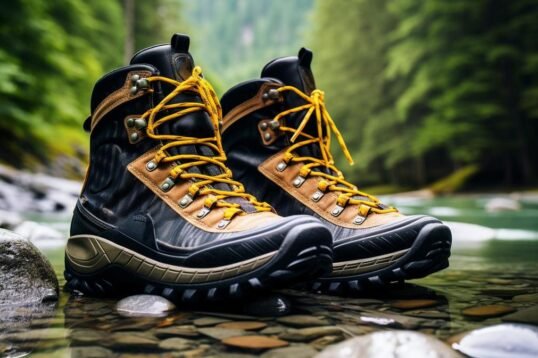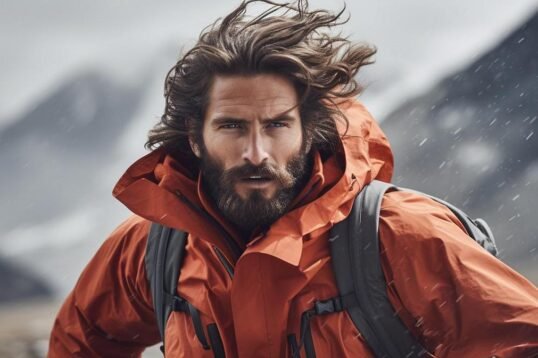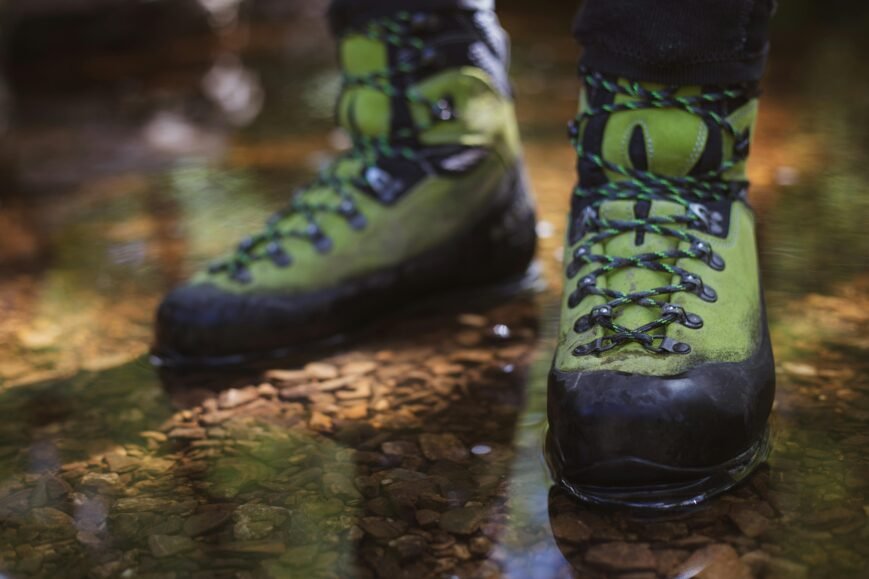- Lightweight women’s hiking boots should be under 3 lbs, waterproof yet breathable.
- Look for boots with GORE-TEX or eVent for top waterproofing.
- Eco-friendly and vegan hiking boots are in demand for ethical reasons; look for certifications.
- The most comfortable boots offer cushioning, support, and a proper fit—break them in before big hikes.
- Merrell and Keen are among the top-rated women’s trail boot brands.
- Best mid-hiking boots balance ankle support and style while being waterproof.
- For different terrains, select boots with appropriate grip, flexibility, and durability; consider user reviews.
- Technological enhancements in boots include durable, water-resistant materials like GORE-TEX.
- Ensure proper fit by considering foot shape, boot size, and the socks you’ll wear.
- Maintain boots by cleaning them after each hike, applying water-based waterproofing products, and storing them in a cool, dry place.
Hey, outdoor lovers! Ready to step up your hike with the perfect pair of boots? It’s trek time, and we know soggy socks can wreck a good trail day. That’s where women’s lightweight waterproof hiking boots come in! In this article, “How Do Women’s Lightweight Waterproof Hiking Boots Measure Up?”, we’ll dig into what makes a boot your rain-proof, feather-light best friend. Stay tuned as we break down top picks, cool tech, and smart styling that’s got your back (and feet) on every hike.
What Features Define the Best Women’s Lightweight Waterproof Hiking Boots?
When we talk about women’s hiking boots, they must hit the mark in waterproofing but stay light. What weight are lightweight hiking boots? They typically weigh less than three pounds per pair. Now, why pick light ones? Heavy boots can slow you down and tire you out. Plus, light boots often mean less break-in time.
A boot’s weight matters, but we also need them to last. So, the boots you choose must balance being light with being tough. When we look at women’s waterproof lightweight hikers, we check for breathability too. This keeps feet dry from the outside water and inside sweat.
The best women’s lightweight waterproof hiking boots come from brands like Merrell and Columbia. They keep feet both dry and comfy. Reviews and ratings from other hikers are gold. They can tell you how boots handle real trails. And when a boot’s design looks good, it’s a nice bonus that can make you feel even better hitting the trails.
Remember, when you go for women’s hiking boots lightweight waterproof features are key. They need to keep out water but let your feet breathe. They should be light, comfy, and also built to last. Look for good reviews and go for brands known for quality. Don’t forget that a great design can make your outdoor adventures even more enjoyable.
How Do Waterproof Technologies in Women’s Hiking Boots Work?
Which hiking boots are most waterproof? Boots with GORE-TEX or eVent are top choices.
These materials keep your feet dry when you hit wet trails. GORE-TEX is one of the best. It stops water from getting in but lets sweat out. This keeps your feet comfy and dry all day.
Leather and synthetics also help keep water out. They work like a shield for your feet. Good care makes them last longer. Cleaning and waterproof sprays do wonders.
New tech in boots means better dryness and more comfort. Always look for the latest in waterproof tech.
It’s also key to know the difference between waterproof and water-resistant boots. Waterproof boots handle serious wetness. Water-resistant boots are for light moisture.
Before you buy, test the waterproof features. Pour water on the boot. Watch if the water beads up and rolls off. This means they are likely to keep your feet dry when hiking. Always choose quality for adventure!
Boots like these can tackle all kinds of weather. They keep feet dry through rain, snow, and mud. So you can focus on the trail and the beautiful views, not your feet!
Why Are Eco-Friendly and Vegan Options Trending in Women’s Hiking Boots?
Are lighter hiking boots better? Yes, lighter boots can be better for many hikers. They reduce fatigue and can also be kind to the earth. Now, let’s dive deeper into why eco-friendly and vegan options are gaining popularity.
People want boots that don’t harm animals or our planet. This demand has led to more ethically-made hiking boots. Brands are now using materials like organic cotton and synthetic leather. These materials are both durable and kind to the earth.
More hikers are choosing vegan boots over traditional ones. Vegan boots match the performance of those made with animal products. Yet, they do so without causing harm to animals. This makes them a top pick for many.
There’s a variety of eco-friendly and vegan boot brands. Some brands are well-known, like Merrell and Columbia. Others are newer and focus solely on making boots that are kind to the earth.
The way we make boots affects the environment. Traditional boot-making can add to pollution and waste. Eco-friendly boots aim to cut this down, using less water and energy.
It’s important to know how to spot real eco-friendly and vegan boots. Look for labels like “100% synthetic” and certifications like PETA-approved vegan. This ensures you’re getting a product that fits your values.
In all, the rise of eco-friendly and vegan hiking boots is a sign of changing times. Hikers now factor in the impact their gear has on the globe. This shift is leading to a growing selection of boots that help our feet and our world.
How Can You Identify the Most Comfortable Trekking Boots for Women?
When it comes to choosing the most comfortable trekking boots for women, there are several important factors to consider. To ensure maximum comfort, it is crucial to pay attention to fitting and sizing, insole and midsole technology, ankle support, and padding, the process of breaking in new boots, as well as popular brands and personal experiences.
Key components that enhance comfort
Key components that greatly enhance comfort in hiking boots include soft foam or gel insoles and good arch support. These features provide additional cushioning and help maintain proper alignment, reducing strain during long treks. Furthermore, the boots should be designed to bend where your foot naturally bends, allowing for a more flexible and comfortable walking experience.
The importance of fitting and sizing
First and foremost, checking the fit and getting the right size is essential for picking the comfiest boots. Trying on boots at the end of the day is recommended since feet tend to swell slightly. This will give you a more accurate idea of how the boots will feel during extended wear. It’s important to ensure that there’s enough space to wiggle your toes, while also making sure that your heels stay put to prevent blisters and discomfort.
Insole and midsole technology for comfort
Insole and midsole technology also play a significant role in overall comfort. High-quality trekking boots typically feature EVA (ethylene-vinyl acetate) or PU (polyurethane) midsoles. These materials not only make the boots cozy to walk in but also help absorb shocks, reducing the impact on your feet and joints.
The role of ankle support and padding
Ankle support and padding are crucial factors to consider to avoid injuries and discomfort. To prevent twisted ankles, it’s important to ensure that the boot has a snug fit around your ankles. Look for boots with soft padding in the ankle area, as this provides extra cushioning and reduces friction, keeping your ankles comfortable and protected.
How to break in new hiking boots
Breaking in new hiking boots is a necessary step to prevent foot pain later on. Before embarking on a major hike, it’s recommended to wear the boots around the house or on short strolls. This allows the boots to gradually shape to the contours of your feet, reducing the likelihood of discomfort and blisters during longer treks.
Popular brands known for comfortable designs
When it comes to popular brands known for comfortable trekking boots, Merrell and Keen are highly regarded. These brands offer stylish designs without compromising on comfort. However, it’s always a good idea to read reviews from other hikers to gather a broader range of opinions and experiences before making a decision.
Personal experiences and testimonials
In addition to considering technical specifications and brand reputation, personal experiences and testimonials can provide valuable insights when selecting trekking boots.
Online forums and reviews are excellent sources of real-life feedback on comfort and performance. If you need assistance or advice, don’t hesitate to reach out to the hiking community for help and guidance.
What Are the Top-Rated Women’s Trail Boots and Where to Find Them?
Are the Merrell hiking boots for women top-rated? Yes, they rank high among the best. Merrell boots are known for their quality. They blend function with comfort, making them a go-to for many hikers. Finding top models is easier than you think.
Reviewing the leading brands in women’s trail boots
When you’re after the best, knowing top brands is key. Companies like Merrell, Salomon, and Keen lead the pack. They invest in research to make shoes both tough and comfy. Their boots can take a beating on rough trails without wearing down.
Comparison of top-rated models and their features
Each brand has its star models. Some boots are light, while others focus more on grip. The best boots do both, giving you the ease to walk and the grip to stay steady. Check out women’s lightweight hiker reviews to see which boots hikers love the most.
Where to buy and find the best deals
You don’t have to search far and wide for good boots. Many stores sell them, but deals are key. Look online and in outdoor shops. Sometimes, the best-value lightweight women’s hiking boots are just a sale away.
Evaluating boot reviews and what to look for
Reviews tell you a lot. They show what works and what doesn’t in real life. Look for repeated praises or issues in reviews. Comfort, waterproofing, and fit should top the list.
User testimonials and expert opinions
Hear from those who’ve been there, done that. Real hikers share their boot stories online. They know which paths these boots can handle. Experts chip in with advice on what makes a boot last.
Awards and accolades for top hiking boots
Some boots win awards for a reason. They’ve proven their worth in tests and on trails. Look for boots with a trophy case of good feedback and industry honors.
Retailers and online platforms for reliable purchases
Want to know you’re getting the real deal? Buy from reputable retailers or directly from the brand. For peace of mind and boots that won’t let you down, stick to the sources you trust.

How Do the Best Women’s Mid-Hiking Boots Balance Performance and Style?
Are waterproof walking boots really waterproof? Yes, the best women’s mid-hiking boots are designed to keep feet dry. They do this using special materials that block water from getting in. But they also let sweat escape to keep your feet comfy.
Mid-hiking boots offer big perks for lady trekkers. They cover your ankles to give support and keep out dirt. Yet, they are not as heavy as tall boots, so you can move with ease. Many hikers love these boots for day walks and light trails.
These boots mix tech with fashion. They often use leather or faux materials. These look good and breathe well while keeping water out. Many come in cool colors and styles. Each one shows off a hiker’s personal taste.
Fashion also shapes these boots. Brands work hard to bring in trendy features. This makes sure you look your best out in nature. The top brands know how to blend cool looks with tough build.
Customers love boots that look good and work well. They want trusty gear that also wins style points. Reviews often praise boots that hit both marks – sturdy for trails and sharp for photos.
In short, the best boots serve both your feet and your fashion sense. They stand up to the wild but also shine in your outdoor snaps. And let’s not forget, they keep your feet bone dry, come rain or creek!
What Attributes Look for When Selecting Women’s Waterproof Hiking Boots for Different Terrains?
What makes hiking boots really waterproof? The most waterproof boots have a blend of a waterproof membrane and sealed seams. Brands add a special layer, like GORE-TEX, to stop water yet allow feet to breathe.
When hunting for rugged hiking boots for women, consider the terrain. Rocky paths demand sturdy soles with deep grooves. Trust me, you want a boot that grips that ground like it’s holding on for dear life. This means looking for waterproof grip hiking boots women’s options that won’t let you down when the trail gets slippery.
Different weather calls for different boots. Frosted mountaintops? Get boots with extra insulation. Planning to trudge through rainy forests? Stick to high-top women’s all-weather trail shoes to keep the water out.
Flexibility matters, but not too much. A boot that’s too bendy won’t save your ankle from twisting. Yet, you don’t want a boot so tough it feels like you’re lugging bricks. Find the middle ground. Boots should move with your feet and still shield them.
For rocky climbs, aim for boots that talk tough and walk tough. Mud and streams on your path? Look for boots folks say they can wade in and still come out dry. It’s about matching the boot to the challenge.
Listen to other hikers. Boots that survive desert heat or icy cold trails will have tales told about them. Trust the stories of boots that have walked the walk. They’re the ones that will take you far.
Remember, choose your boots like they’re your travel buddy, because they are. Get the ones that will face the adventures ahead of you.
In What Ways Can Technology Enhance the Waterproof and Durability Aspects of Women’s Hiking Boots?
Are lightweight hiking boots better? Yes, they often are. Now, let’s dive deeper.
New tech makes women’s hiking boots better than ever. Imagine boots that keep your feet dry no matter the puddles you step into. That’s what today’s boots offer thanks to smart design. High-traction hiking boots female adventurers love come from advanced science and nifty materials.
In boot materials, we see big leaps. Makers now use stuff that stays tough longer and laughs at water. They work hard in labs to make sure boots last on trails.
You also get a better grip with new soles. They stop slips on wet rocks and keep you stable when climbing steep hills. This comes from smart tech that understands the tough path hikers face.
We now even have boots with built-in tech. Think about shoes telling you how far you’ve hiked or the trail you’re on. This smart tech keeps getting better.
For keeping water out and boots alive longer, tech plays a big role. Methods like sealing seams and using waterproof liners are key. They lock water out so you can hike comfortably.
Materials like GORE-TEX help a lot. They let your feet breathe but block water. Durability comes from how these materials resist wear and tear over time. They bend and move but don’t break down after a few hikes.
So, when you pick boots, check what tech they boast. It might just make your hike dry and your boots last for miles upon miles. Long-lasting hiking shoes for women are no longer a wish, but a reality, thanks to these tech advances.
What Should You Know About the Fit and Sizing of Women’s Waterproof Hiking Boots?
Know your feet for the best fit in women’s waterproof hiking boots. A sure fit means measuring your feet right. Your foot’s shape matters as much as the size. Female hikers’ waterproof shoes should hug your feet just right. Not too tight, not too loose.
For feet that are wide, narrow, or different, look for women’s supportive trail boots made just for them. Many brands now design for these shapes. So, pick what feels natural and snug for you.
Socks can change how your boots fit. Thick ones can make boots feel tight, and thin ones – loose. Always wear the socks you’ll hike in when you try on women’s waterproof hiking booties. This helps ensure a perfect match.
Here are tips for picking out the best hiking boots:
- Measure your feet in the afternoon. That’s when they are at their largest.
- Try on different sizes and remember one brand’s fit can differ from another’s.
- Walk around the store, make sure there’s space at the toes, and watch for any spots that rub.
Getting this right means a more joyous hike. You’ll have fewer blisters and more smiles on the trail. The best hiking boots for women feel like a part of you, not just gear on your feet.
How to Care for and Maintain Your Lightweight Waterproof Hiking Boots?
Are waterproof walking boots really waterproof? Yes, they are. But they need care to stay that way. For your boots to last, you must clean and care for them right. For women’s lightweight expedition boots, remove dirt after each hike. Use a soft brush and water for this. If you have quick-dry women’s hiking boots, let them air dry away from heat.
Maintenance keeps boots waterproof for longer. Use a cleaner made for boots. Then, apply a water-based waterproofing product. Do this often for best results. Always follow the product instructions.
For storage, keep boots in a cool, dry place. This helps them keep their shape and stops mold from growing. Don’t store them wet or in damp places.
You can fix small issues at home. Use a strong glue for any small tears or separated soles. Replace worn laces to avoid tripping.
Sometimes, you may need to seek a pro. Look for a service that works on hiking boot maintenance. They can do the more complex work that is tough to do at home.
Remember the do’s and don’ts. Do keep boots clean, dry, and well-oiled. Do not dry them with heat or leave them in sunlight. These tips keep boots ready for your next adventure.
Conclusion
To end, we dove deep into women’s hiking boots, highlighting weight, waterproofing, and comfort. We explored what makes boots last and keep feet dry. The right fit for you matters, and we showed you how. Remember, care extends your boots’ life. Now, choose your best pair and hit those trails with confidence!
![]()







